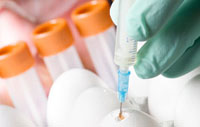Bird flu vaccine less effective than previously thought, analysis finds
The U.S. government is weighing approval of a bird flu vaccine that a new analysis found is even less effective than previously thought.

Sanofi Aventis SA believes the benefits of the vaccine outweigh its risks. However, in a clinical trial, the two-shot series appears to provide protection to just 45 percent of adults who received the highest dose.
An earlier, interim analysis of the same study suggested it prompted a protective immune response in 54 percent of patients, when measured 28 days after getting the second shot. The New England Journal of Medicine published those results in March 2006.
The Food and Drug Administration released the more recent analysis ahead of a Tuesday meeting of outside experts asked to review the vaccine. The FDA said the 452-person study showed the vaccine against the deadly bird-flu strain called H5N1 is indeed safe, but it remained unclear whether it would be effective.
The FDA is asking the panel whether Sanofi provided enough data to back approval of its bird flu vaccine or if more are needed. The agency is not required to follow the advice of its advisory committees, but usually does. The vaccine is the first against the H5N1 influenza strain to seek FDA approval.
Effectiveness was measured by the antibodies patients developed against the flu strain. The results appear to fall well below what is expected of seasonal flu vaccines. Those regular flu shots, for example, protect 75 percent to 90 percent of vaccinated adults younger than 65.
The newer analysis used final data, while the earlier study used interim results, Paris-based Sanofi said. The later analysis also used tougher standards to show the vaccine works, according to company documents released by the FDA.
The modest protective effects of the vaccine were seen in patients who received two 90-microgram doses of vaccine. The two shots contain 12 times the 15-microgram dose contained in regular winter flu shots.
Already, there are further studies under way that are looking at the use of immune boosters, called adjuvants, to try to improve the effectiveness of the H5N1 vaccine. Eventually, adjuvants also might shrink the needed dose for a pandemic vaccine closer to what's now used in seasonal shots, the AP says.
Health officials also are studying the development of cell-based vaccines, which would be faster to produce in an outbreak of deadly flu than are current egg-based vaccines. The FDA suggested the Sanofi vaccine, if approved, could be used on an interim basis until others are developed.
The government plans to buy and stockpile enough vaccine for 20 million people, including emergency and health care workers.
Since it began ravaging Asian poultry farms in late 2003, the H5N1 strain of bird flu has killed at least 167 people worldwide, according to the World Health Organization. Health officials worldwide worry the strain could mutate into a form that easily spreads from person to person, sparking a pandemic.
Subscribe to Pravda.Ru Telegram channel, Facebook, RSS!




